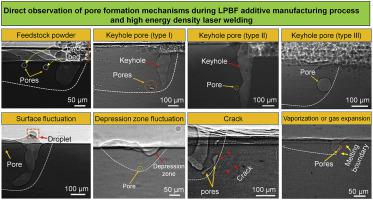International Journal of Machine Tools and Manufacture ( IF 14.0 ) Pub Date : 2020-04-08 , DOI: 10.1016/j.ijmachtools.2020.103555 S. Mohammad H. Hojjatzadeh , Niranjan D. Parab , Qilin Guo , Minglei Qu , Lianghua Xiong , Cang Zhao , Luis I. Escano , Kamel Fezzaa , Wes Everhart , Tao Sun , Lianyi Chen

|
Laser powder bed fusion (LPBF) is a 3D printing technology that can print parts with complex geometries that are unachievable by conventional manufacturing technologies. However, pores formed during the printing process impair the mechanical performance of the printed parts, severely hindering their widespread application. Here, we report six pore formation mechanisms that were observed during the LPBF process. Our results reconfirm three pore formation mechanisms - keyhole induced pores, pore formation from feedstock powder and pore formation along the melting boundary during laser melting from vaporization of a volatile substance or an expansion of a tiny trapped gas. We also observe three new pore formation mechanisms: (1) pore trapped by surface fluctuation, (2) pore formation due to depression zone fluctuation when the depression zone is shallow and (3) pore formation from a crack. The results presented here provide direct evidence and insight into pore formation mechanisms during the LPBF process, which may guide the development of pore elimination/mitigation approaches. Since certain laser processing conditions studied here are similar to the situations in high energy density laser welding, the results presented here also have implications for laser welding.
中文翻译:

直接观察LPBF增材制造过程和高能量密度激光焊接过程中的孔形成机理
激光粉末床熔合(LPBF)是一种3D打印技术,可以打印具有传统制造技术无法实现的复杂几何形状的零件。然而,在印刷过程中形成的孔损害了印刷部件的机械性能,严重地阻碍了它们的广泛应用。在这里,我们报告在LPBF过程中观察到的六个孔形成机制。我们的结果再次证实了三种孔形成机制-锁孔引起的孔,原料粉末形成的孔以及在挥发性物质汽化或微小捕集气体膨胀引起的激光熔融过程中沿熔融边界形成的孔。我们还观察到了三种新的孔隙形成机制:(1)被表面波动所困的孔隙,(2)当凹陷区较浅时,由于凹陷区波动而形成的孔隙;(3)由裂缝形成的孔隙。本文介绍的结果为LPBF过程中的孔形成机理提供了直接的证据和见识,这可能指导孔消除/缓解方法的发展。由于此处研究的某些激光加工条件与高能量密度激光焊接中的情况相似,因此此处显示的结果也对激光焊接有影响。











































 京公网安备 11010802027423号
京公网安备 11010802027423号